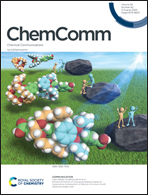A rare olefin 1,1-carboboration reaction opens a synthetic pathway to an unusually structured frustrated Lewis pair†
Abstract
(2,6-Dimesitylphenyl)P(vinyl)25d reacts with HB(C6F5)2 in a sequence involving a rare example of a 1,1-carboboration of an olefin to give the borylated tetrahydrophosphole derivative 6d. Compound 6d is an active frustrated Lewis pair that splits dihydrogen under mild conditions and serves as a metal-free hydrogenation catalyst. It also adds to carbon dioxide. Compound 6d serves as an intermediate in the HB(C6F5)2 catalyzed aryl(divinyl)phosphane (5d) to dihydrophosphole conversion.



 Please wait while we load your content...
Please wait while we load your content...